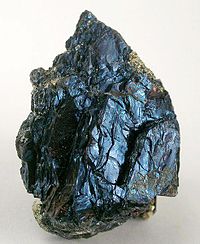
Photo from wikipedia
Abstract This first part of research presents an analysis of the electro-assisted reductive leaching (ERL) of refractory chalcopyrite (CuFeS2) performed in HCl media using an electrolytic cell operated at room… Click to show full abstract
Abstract This first part of research presents an analysis of the electro-assisted reductive leaching (ERL) of refractory chalcopyrite (CuFeS2) performed in HCl media using an electrolytic cell operated at room temperature and pressure. This is as an alternative approach to decrease the passivation phenomenon observed in the ERL process with sulfuric acid, which favored the chalcopyrite reduction kinetics at pulp densities >10 g/L. Different variables were optimized to understand the electro-reduction kinetics of chalcopyrite such as: acid concentration, current density and pulp density. The reaction mechanism proposed was complemented with the electrochemical techniques, and SEM-EDS and X-ray diffraction analyses. The results revealed that electro-reduction of chalcopyrite performed in HCl at a pulp density of 100 g/L present a higher reduction rate than that of the sulfuric acid system. From a mechanistic viewpoint, chalcopyrite can be sequentially reduced to chalcocite and metallic copper, respectively. The latter is a very reactive species which can be easily oxidized in the presence of air and remaining hydrochloric acid, to cuprous hydroxychloride or atacamite species (Cu2Cl(OH)3) and cuprite (Cu2O) when the solid residue is withdrawn from the reactor. These copper species are highly soluble in aqueous solutions which can permit the recovery of copper. From an energetic viewpoint, the energy consumption of the HCl electrolytic system is lower than that of the H2SO4 electrolytic system.
Journal Title: Hydrometallurgy
Year Published: 2018
Link to full text (if available)
Share on Social Media: Sign Up to like & get
recommendations!